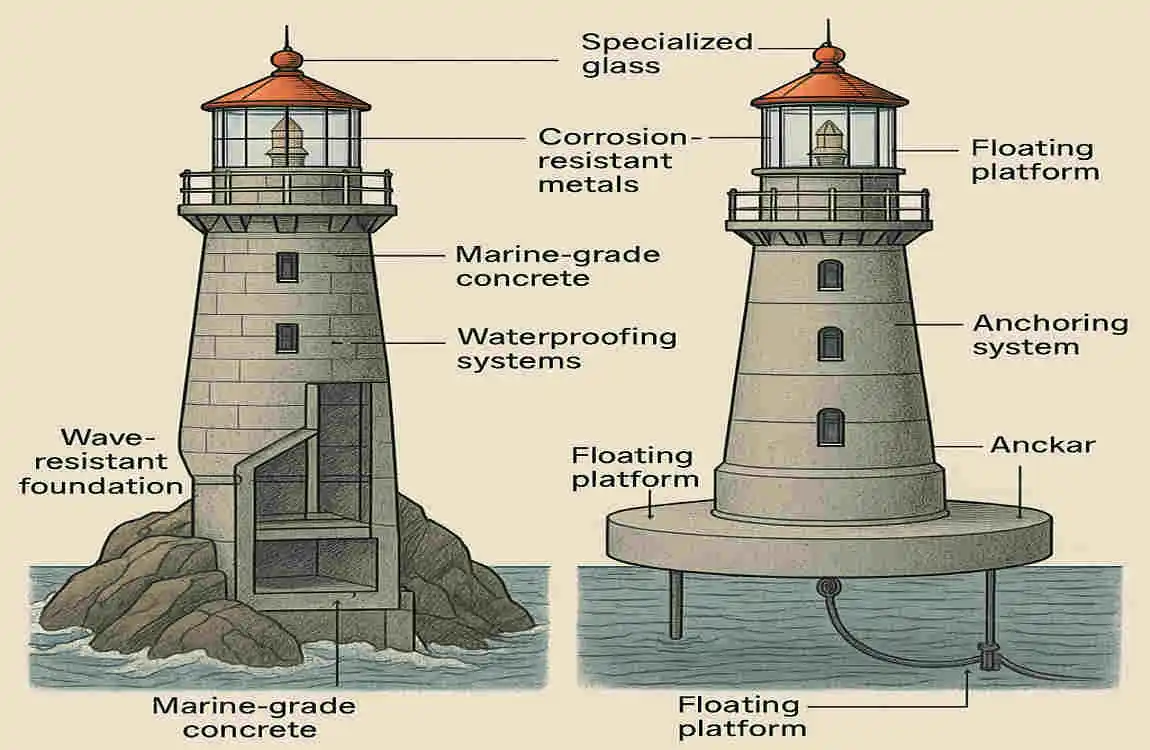Lighthouses are iconic structures that have been guiding ships safely to shore for centuries. These towering beacons of light serve a critical purpose in navigation and safety, helping sailors navigate treacherous waters and avoid dangerous obstacles. But have you ever wondered what materials are used to build these remarkable structures?
We’ll discuss the challenges that lighthouses face in their harsh environments and how material selection plays a crucial role in ensuring their durability and functionality.
Understanding the Function and Environment of a Lighthouse

Before we delve into the specific materials used in lighthouse construction, it’s essential to understand the function and environment in which these structures operate. Lighthouses are exposed to some of the harshest conditions on Earth, facing relentless waves, corrosive saltwater, strong winds, and even ice in colder climates.
Environmental Challenges
The environment surrounding a lighthouse can be incredibly demanding. Saltwater corrosion is a constant threat, slowly eating away at the structure over time. Powerful waves can batter the lighthouse, putting immense pressure on its foundation and walls. In colder regions, ice can form and cause significant damage to the structure. These environmental challenges make material selection crucial in ensuring the longevity and effectiveness of a lighthouse.
Importance of Material Selection
Given the harsh conditions that lighthouses face, selecting the right materials is paramount. The materials must be able to withstand the constant assault of the elements while maintaining the structural integrity of the lighthouse. They should be resistant to corrosion, durable against the forces of nature, and able to endure for decades, if not centuries.
Types of Lighthouses and Material Impact
There are different types of lighthouses, each with its own unique requirements for materials. Coastal lighthouses, situated on the shore, may face other challenges compared to offshore lighthouses, which are built on isolated platforms or even floating structures. The type of lighthouse can significantly impact the choice of materials, with some designs requiring more flexible or specialized materials to accommodate their unique needs.
Historical Materials Used to Build Lighthouses
Throughout history, various materials have been used to construct lighthouses. Let’s explore some of the most common historical materials and their characteristics.
You may also read (where exactly is unspeakable island house located).
Wood
In the early days of lighthouse construction, wood was a popular choice due to its availability and ease of use. Wooden lighthouses were often built using timber frames and planks, providing a sturdy structure that could be erected relatively quickly.
However, wood has its drawbacks when used in lighthouse construction. It is susceptible to decay and rot, especially in the humid, salty air surrounding many lighthouses. Additionally, wooden structures are highly flammable, posing a significant risk in the event of a fire. Despite these challenges, some wooden lighthouses have stood the test of time, such as the Cape Hatteras Lighthouse in North Carolina, which was initially built with a wooden tower in 1803.
Brick and Stone Masonry
As lighthouse construction techniques advanced, brick and stone masonry became the preferred materials for many lighthouses. These materials offered superior strength and weather resistance compared to wood, making them ideal for the harsh coastal environments.
Brick and stone lighthouses were built using a combination of bricks, stones, and lime mortar. The mortar acted as a binding agent, holding the bricks and stones together to create a solid, durable structure. Many famous lighthouses, such as the Eddystone Lighthouse in England and the Cape Lookout Lighthouse in North Carolina, were constructed using brick and stone masonry.
One of the key advantages of brick and stone lighthouses is their longevity. Some of these structures have stood for centuries, withstanding the relentless forces of nature. The use of lime mortar, which is more flexible than modern cement, allowed the masonry to flex and absorb the impact of waves and storms, contributing to their remarkable durability.
Modern Materials in Lighthouse Construction
While brick and stone masonry remain popular choices for some lighthouses, modern construction techniques have introduced new materials that offer improved durability and flexibility. Let’s explore some of the most common modern materials used in lighthouse construction.
Concrete
Concrete has become the primary material for many modern lighthouse towers. Its durability, strength, and ability to be molded into various shapes make it an ideal choice for withstanding the harsh coastal environment.
Concrete lighthouses are often constructed using a combination of reinforced concrete and steel reinforcement bars (rebar). The rebar provides additional strength and stability to the structure, helping it withstand the forces of nature. Concrete can be poured into molds to create the desired shape of the lighthouse, allowing for more creative and efficient designs.
One of the advantages of concrete is its corrosion resistance. Unlike some metals, concrete is not affected by saltwater, making it an excellent choice for lighthouses exposed to constant moisture. Additionally, concrete can be easily repaired and maintained, extending the life of the lighthouse.
Steel and Iron
Steel and iron are commonly used in the construction of skeletal lighthouses, which feature a framework of metal supports instead of a solid tower. These materials offer strength, flexibility, and resistance to extreme weather conditions.
Prefabricated iron and steel frameworks can be assembled on-site, allowing for faster and more efficient construction. The skeletal design of these lighthouses reduces the wind resistance, making them more stable in high winds and storms.
An example of a steel skeletal lighthouse is the Finn Point Range Lighthouse in New Jersey. Built in 1876, this lighthouse features a steel framework that has withstood the test of time and continues to guide ships safely along the Delaware River.
Specialized Materials and Techniques for Offshore and Floating Lighthouses

Offshore and floating lighthouses present unique challenges that require specialized materials and construction techniques. Let’s explore some of the materials and methods used in these types of lighthouses.
Floatable Materials
Floating lighthouses, also known as lightships, require materials that are buoyant and resistant to the corrosive effects of saltwater. These lighthouses are typically constructed using steel or aluminum, which are lightweight and can be easily shaped into the necessary hull design.
The hull of a lightship is often filled with foam or other buoyant materials to provide additional stability and prevent sinking. The superstructure of the lightship, which houses the living quarters and light tower, may be constructed using a combination of steel, aluminum, and fiberglass for durability and weather resistance.
Screwed Piles for Ice Damage Mitigation
In colder climates, offshore lighthouses face the additional challenge of ice damage. To mitigate this risk, some lighthouses are constructed using screwed piles, which are long, steel rods that are screwed into the seabed.
The screwed piles provide a stable foundation for the lighthouse and help to absorb the impact of ice floes. The steel construction of the piles is resistant to the corrosive effects of saltwater and can withstand the pressure of ice against the structure.
Fixed Light Platforms
Offshore lighthouses used in conjunction with oil exploration often feature fixed light platforms. These platforms are typically constructed using steel and concrete, providing a stable and durable base for the lighthouse.
The fixed light platform is anchored to the seabed using piles or caissons, ensuring that it remains in place even in rough seas. The lighthouse itself may be constructed using a combination of steel, concrete, and fiberglass, depending on the specific design and environmental conditions.
Recent Advances in Materials and Construction Technology
Advancements in materials and construction technology have led to the development of new techniques and materials for lighthouse construction. Let’s explore some of the recent innovations in this field.
Epoxy Resins and Fiberglass Reinforcements
Epoxy resins and fiberglass reinforcements have become popular choices for improving the durability and water resistance of lighthouses. Epoxy resins can be applied to the surface of the lighthouse, creating a protective barrier against the elements.
Fiberglass reinforcements can be embedded within the concrete or other materials used in lighthouse construction, adding strength and flexibility to the structure. These reinforcements help to distribute the forces of nature more evenly, reducing the risk of cracks and damage.
Prefabricated Components and Modern Composites
Prefabricated components and modern composites have revolutionized the way lighthouses are constructed. These materials can be manufactured off-site and then assembled on location, reducing construction time and costs.
Modern composites, such as carbon fiber and Kevlar, offer exceptional strength and durability while being lightweight and resistant to corrosion. These materials can be used in the construction of lighthouse towers, lantern rooms, and other components, providing a long-lasting and low-maintenance solution.
Custom Finishes for Decoration and UV Protection
In addition to structural materials, lighthouses may also feature custom finishes for decoration and UV protection. Quartzite flagstone, for example, can be used to clad the exterior of the lighthouse, providing a beautiful and durable finish.
Quartzite is a natural stone that is highly resistant to weathering and UV damage, making it an ideal choice for lighthouses exposed to the elements. The flagstone can be cut and shaped to fit the contours of the lighthouse, creating a unique and visually appealing design.
Extending the Life Span of Lighthouses
Modern technology has also enabled the development of techniques to extend the life span of lighthouses. Regular maintenance and inspections can help identify and address any issues before they become significant problems.
You may also read (the ultimate guide to house building materials).
Additionally, the use of advanced materials and construction techniques can help to prevent common issues such as corrosion, cracking, and erosion. By investing in these technologies, lighthouse operators can ensure that these iconic structures continue to guide ships safely for generations to come.
Construction Process Overview: Using Materials Effectively
Now that we’ve explored the various materials used in lighthouse construction, let’s take a closer look at the construction process and how these materials are applied effectively.
Base Foundations
The foundation of a lighthouse is crucial for its stability and longevity. For many lighthouses, the foundation is constructed using concrete, which provides a solid and durable base.
In some cases, plywood and fiberglass may be used to create a sealed base for more miniature lighthouses or models. These materials offer a lightweight and cost-effective solution while still providing the necessary strength and water resistance.
Waterproofing and Sealing
Given the harsh coastal environment, waterproofing and sealing are essential steps in lighthouse construction. Epoxy layers can be applied to the exterior of the lighthouse, creating a protective barrier against water and salt.
Silicone sealants are often used to fill any gaps or joints in the structure, preventing water from seeping in and causing damage. These sealants are flexible and resistant to the elements, ensuring a long-lasting and effective seal.
Glass and Light Diffusion
The lantern room of a lighthouse, which houses the light source, often features glass panels to allow the light to shine through. Etched glass windows can be used to diffuse the light, creating a more even and effective beam.
The glass panels are typically sealed with silicone to prevent water from entering the lantern room. The use of high-quality glass and proper sealing techniques ensures that the light remains visible and effective, even in the harshest conditions.
Maintenance Considerations Related to Materials
The choice of materials used in lighthouse construction can have a significant impact on the maintenance requirements and costs. Let’s explore some of the key considerations related to maintenance.
Durability and Corrosion Resistance
The durability and corrosion resistance of the materials used in a lighthouse can significantly influence its maintenance needs. Materials such as concrete, steel, and fiberglass are generally more resistant to corrosion and weathering, requiring less frequent maintenance.
However, even the most durable materials can be affected by the constant exposure to saltwater and harsh weather. Regular inspections and maintenance are essential to identify and address any signs of corrosion or damage before they become significant issues.
Challenges of Salt Corrosion and Freeze-Thaw Cycles
Salt corrosion and freeze-thaw cycles are two of the most significant challenges faced by lighthouses in coastal environments. Saltwater can slowly erode the structure, while the repeated freezing and thawing of water can cause cracks and damage.
To mitigate these challenges, lighthouse operators must regularly clean and treat the structure to remove salt buildup and prevent corrosion. In colder climates, additional measures such as heating systems or ice-breaking equipment may be necessary to protect the lighthouse from freeze-thaw damage.
Modern Material Advantages in Reducing Upkeep Costs
The use of modern materials and construction techniques can help reduce the upkeep costs of lighthouses. Materials such as epoxy resins, fiberglass reinforcements, and modern composites are more resistant to the elements and require less frequent maintenance.
Additionally, the use of prefabricated components can simplify the maintenance process, allowing for easier replacement or repair of damaged parts. By investing in these modern materials and techniques, lighthouse operators can save money on maintenance and extend the life of the structure.
Case Studies of Famous Lighthouses and Their Materials
To illustrate the impact of materials on lighthouse construction, let’s explore some case studies of famous lighthouses and the materials used in their construction.
Historical Lighthouse: Chola Lighthouse
The Chola Lighthouse, located in Tamil Nadu, India, is a remarkable example of a historical lighthouse constructed using brick and mortar. Built in the 13th century, this lighthouse has stood the test of time, guiding ships safely along the coast for over 700 years.
The use of brick and lime mortar allowed the Chola Lighthouse to withstand the harsh coastal environment and frequent storms. The flexibility of the lime mortar helped to absorb the impact of waves and wind, while the strength of the brick provided a solid and durable structure.
Modern Concrete and Steel Lighthouse: Cordouan Lighthouse
The Cordouan Lighthouse, located off the coast of France, is a stunning example of a modern lighthouse constructed using concrete and steel. Built in the late 19th century, this lighthouse features a concrete tower reinforced with steel, providing exceptional strength and durability.
The use of concrete and steel allowed the Cordouan Lighthouse to withstand the powerful waves and storms of the Atlantic Ocean. The reinforced concrete structure has proven to be highly resistant to corrosion and weathering, requiring minimal maintenance over the years.
Material Choice and Local Environment
The choice of materials used in lighthouse construction is often influenced by the local environment and available resources. In areas with abundant stone or brick, these materials may be the preferred choice for lighthouse construction.
In contrast, regions with limited access to traditional materials may opt for more modern solutions such as concrete, steel, or fiberglass. The specific environmental challenges faced by the lighthouse, such as ice or extreme weather, can also influence the choice of materials and construction techniques.
Environmental and Sustainability Considerations in Lighthouse Construction
As we become more aware of the impact of our actions on the environment, it’s essential to consider the environmental and sustainability aspects of lighthouse construction. Let’s explore some of the key considerations in this area.
Impact of Materials on the Environment
The materials used in lighthouse construction can have a significant impact on the environment. Traditional materials such as brick and stone may require extensive mining and processing, leading to habitat destruction and pollution.
Modern materials such as concrete and steel also have environmental impacts, particularly in terms of their carbon footprint during production. However, these materials can be more durable and require less frequent replacement, potentially reducing their overall environmental impact over time.
Use of Sustainable Materials and Green Building Practices
To minimize the environmental impact of lighthouse construction, builders can opt for sustainable materials and green building practices. Recycled or locally sourced materials can reduce the carbon footprint of the project and support local economies.
Green building practices such as energy-efficient lighting systems, rainwater harvesting, and waste reduction can also help to minimize the environmental impact of the lighthouse. By incorporating these sustainable elements into the design and construction process, lighthouse operators can reduce their ecological footprint and promote a more sustainable future.
Longevity Benefits in Reducing the Need for Rebuilding
One of the key benefits of using durable and high-quality materials in lighthouse construction is the reduced need for rebuilding. By selecting materials that can withstand the elements for decades or even centuries, lighthouse operators can minimize the environmental impact of construction and demolition.
A well-built lighthouse that requires minimal maintenance and repair can serve its purpose for generations, reducing the need for new construction projects. This longevity not only saves money and resources but also helps to preserve the natural beauty and ecosystem surrounding the lighthouse.
You may also read (frame houses the perfect blend of style and function).




